
About UsThe Numismatic Bibliomania Society is a non-profit organization promoting numismatic literature. For more information please see our web site at coinbooks.org SubscriptionsThose wishing to become new E-Sylum subscribers (or wishing to Unsubscribe) can go to the following web page link MembershipThere is a membership application available on the web site Membership Application To join, print the application and return it with your check to the address printed on the application. Membership is only $15 to addresses in the U.S., $20 for First Class mail, and $25 elsewhere. For those without web access, write to: David M. Sundman, Secretary/TreasurerNumismatic Bibliomania
Society AsylumFor Asylum mailing address changes and other membership questions, contact David at this email address: dsundman@LittletonCoin.com SubmissionsTo submit items for publication in The E-Sylum, just Reply to this message, or write to the Editor at this address: whomren@coinlibrary.com
BUY THE BOOK BEFORE THE COINYou won't regret it! |
- WAYNE'S WORDS: THE E-SYLUM SEPTEMBER 13, 2009
- COMMENTS ON THE E-SYLUM'S 11TH ANNIVERSARY
- CHARLES DAVIS OCTOBER 17 2009 SALE CATALOG ONLINE
- ORIGINAL "RED BOOK" SHOP DUMMIES ON DISPLAY AT PHILADELPHIA EXPO
- PHILIPPINE NUMISMATIC LITERATURE SALES STRONG
- C4 COLONIAL NUMISMATIC LITERATURE SURVEY
- INTERNATIONAL NUMISMATIC LIBRARIES' NETWORK CREATED
- NUMISMATIC AUTHORS HIGHLIGHTED IN PAPER MONEY
- UNIVERSITY OF MICHIGAN REPRINT OF PRIME'S COINS, MEDALS AND SEALS
- MORE ON MARDI GRAS DOUBLOON LITERATURE
- VOCABULARY WORDS: COUNTERSTAMP AND COUNTERMARK
- NEW DEVELOPMENTS IN THE CASE OF THE FORMER ANA EXECUTIVE DIRECTOR
- GEOLOGY AND NUMISMATICS
- THE 1959 HAWAII GOLD STATEHOOD MEDAL
- MORE ON ANNIVERSARY TERMINOLOGY
- U.S. LARGE CENT FETCHES RECORD PRICE OVER $1 MILLION
- MORE ON SALMON P. CHASE AND HIS ONE DOLLAR GREENBACK
- IS A LIBRARY WITHOUT BOOKS STILL A LIBRARY?
- MYSTERIOUS LEDGER SIX NINE FOUR: THE OLD COUNTERFEIT STAMPER
- MYSTERIOUS LEDGER SIX NINE FOUR: THE ELLA QUINN HOARD
- GOOD GUYS WIN IN COIN THEFT ATTEMPT
- BILL FIVAZ AND THE U. S. FRIGATE CONSTELLATION MEDALS
- COMMEMORATIVE $150 BANKNOTE ISSUED IN HONG KONG
- BANK OF JAMAICA ELIMINATES UNUSUAL CIRCULATING COIN SHAPES
- WAYNE'S NUMISMATIC DIARY: SEPTEMBER 8, 2009
- CORRECTION: ASHMOLEAN MUSEUM'S HEBERDEN COIN ROOM NOT YET OPEN
- NEW ZEALAND MEDAL THIEF PLEADS GUILTY
- LUCKY COIN PLACED ATOP JOHNSTON SMOKESTACK
- THE CAT ATE MY HOMEWORK - AND MY LUNCH MONEY, TOO
- FEATURED WEB SITE: WATERMARKS
WAYNE'S WORDS: THE E-SYLUM SEPTEMBER 13, 2009

Among our recent subscribers are Bruce Baryla, and Robert P Puddester. Welcome aboard! We now have 1,263 subscribers.
This week we open with some comments on our recent anniversary, and word of Charlie Davis' next numismatic literature sale. Other topics include the newly-created International Numismatic Libraries Network, Geology in Numismatics, and Salmon P. Chase and his portrait.
To learn about the lucky smokestack coin, Max the E-Sylum Wonder Dog and the library that doesn't have any damn books, read on.
Wayne Homren
Numismatic Bibliomania Society
COMMENTS ON THE E-SYLUM'S 11TH ANNIVERSARY
Ron Guth, President of PCGS CoinFacts writes:
Congratulations on the end of eleven successful years. The E-Sylum is one of my favorite "reads" each week and is certainly among the most entertaining and informative. I'm glad you're still enjoying the work and I hope you never quit.
Paul Petch writes:
In reading over last week's issue and noting your comment that it was 11 years ago that E-Sylum publication began, I took a look back in my E-Sylum e-mail folder and simply wanted to say that I have been in from the start. I don't recall the events that caused me to be signed up as a charter member, but I have always been a happy participant. Those first few issues were pretty slim and I notice that volume 1 ended with issue #12 at the end of December 1998.
Numismatic literature dealer Douglas Saville writes:
It is amazing that the E-Sylum has been going for 11 years…… well done!
I am just back from the International Numismatic Congress in Glasgow - I had lots of books for sale there – and the long drive up there with some 250 books paid off - the majority sold!!!
It was great to see so many old and new friends there. Your note about the 11th year for The E-Sylum reminded me that it was precisely 40 years (yes!) on September 4th (1969) since I started work in Spink's Book Department when Howard Linecar was the Manager. In Glasgow I met up with very many old friends, some of whom were interested in coins well before I came onto the scene - so I have known many of them for 40 years.
All best to you and I hope The E-Sylum continues for many years to come.
To read the earlier E-Sylum article, see: ANNIVERSARY OF THE FIRST E-SYLUM ISSUE ON SEPTEMBER 4, 1998 (www.coinbooks.org/esylum_v12n36a02.html)
CHARLES DAVIS OCTOBER 17 2009 SALE CATALOG ONLINE
Numismatic literature dealer Charles Davis writes:
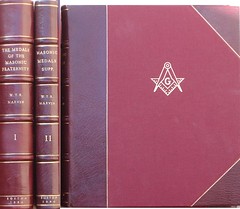 I have posted my mail bid sale closing October 17 on the vcoins web site where it is available at www.vcoins.com/ancient/charlesdavis. The sale includes consignments from colonial researchers/writers Michael Hodder, John Lorenzo and Bob Vlack in addition to a significant section on British tokens.
I have posted my mail bid sale closing October 17 on the vcoins web site where it is available at www.vcoins.com/ancient/charlesdavis. The sale includes consignments from colonial researchers/writers Michael Hodder, John Lorenzo and Bob Vlack in addition to a significant section on British tokens.
The highlights include the full leather 21 volume set of Ford catalogues presented to lead cataloguer Hodder, 2 original Dalton & Hamers with one being unbound in wrappers and possibly unique, 2 sets of Burns on Scottish coins, regular and large paper, a matching Morocco 2 volume set of Marvin Masonic Medals, Elder's 1918 McCoy sale of Political with photographic plates, plated Chapmans including John Story Jenks, and an 1878 Crosby Early Coins of America.
We have placed 125 photos as well on the web site and will be adding more daily. We will have some lots on display at the Whitman Philadelphia show September 23-26. Catalogues will be mailed in about a week.
To access the catalog, see: www.vcoins.com/ancient/charlesdavis
ORIGINAL "RED BOOK" SHOP DUMMIES ON DISPLAY AT PHILADELPHIA EXPO
We thought your readers would like to know that the original Red Book shop dummy, original Blue Book shop dummy, and an antique Whitman Publishing printing plate will be on display at the upcoming Whitman Coin & Collectibles Philadelphia Expo, September 24-26 at the Pennsylvania Convention Center.
Original Red Book Shop Dummy: Don't let its blue color fool you: this is the original "shop dummy" of the first edition of the Red Book (the Guide Book of United States Coins), which would be published in late 1946. Note the vellum hand-lettered cover sketch. . . the penciled-in text and notations. . . the red editorial markups. This is numismatic history in process-a rare behind-the-scenes glimpse into the making of the hobby's best-selling guide book.
Original Blue Book Shop Dummy: Before the Red Book there was the Blue Book-A Hand Book of United States Coins, which debuted in 1942. This is the original shop dummy for the first edition, complete with penciled notes and pasted-in content-a rare, indeed unique, piece of numismatic history from the Whitman Publishing archives.
Antique Whitman Publishing Printing Plate: This old-fashioned printing plate, copyright 1940, was used to print one of Whitman's famous coin boards - in this case, "Barber or Liberty Head Half Dollar Collection No. 2."
Whitman Publishing started making its coin boards in the early 1930s, followed by coin folders in 1940. They took the hobby by storm - making it easy to collect and display coins from pocket change - and helped usher in the Great Depression era's popular craze for coin collecting.
In addition to these displays, there will be a currency exhibit featuring 10 of the most interesting U.S. notes, including the $1,000 "Grand Watermelon"; an exhibit featuring the Nova Constellatio pattern coins; and several other interesting, educational exhibits.
There will also be several free programs and meetings.
THURSDAY, SEPTEMBER 24
2 p.m.
"Announcing the Red Book's New Professional Edition"
Room 305
A new, expanded "Red Book on Steroids" is coming to the hobby. The Guide Book of United States Coins, Professional Edition, is for intermediate to advanced collectors, professional coin dealers, and investors. Find out what makes this the one reference --- after the regular-edition Red Book, of course --- that you absolutely must have in your numismatic library. It debuts in October; get a sneak peek now, ahead of the crowd!
FRIDAY, SEPTEMBER 25
1 p.m.
"Great Numismatists I've Met: From B. Max Mehl to Present Day"
Room 305
Among modern numismatists, few have reached the legendary stature of Q. David Bowers, a coin dealer, researcher, auctioneer, and award-winning author since the early 1950s. In this fascinating lecture and Q&A session, Bowers weaves tales of some of the personalities he's met and become friends with over the years. A fireside chat with a hobby legend, telling about other hobby legends --- you'll kick yourself if you miss this one!
2 p.m.
"Abraham Lincoln: The Image of His Greatness"
Room 305
Whitman publisher Dennis Tucker presents a behind-the-scenes look at the making of Fred Reed's monumental new book, Abraham Lincoln: The Image of His Greatness. Marvel at how our nation's greatest president has been portrayed in an impressive collection of coins, medals, tokens, paper currency, scrip, and other collectibles and mainstream media. Rumor has it that visitors are invited to have a free souvenir photo-portrait made with Mr. Lincoln at booth #461 this afternoon and Saturday morning on the bourse floor.
SATURDAY, SEPTEMBER 26
2 p.m.
"History of the Red Book: 63 Years in the Hobby, and Going Strong"
Room 305
No other coin guide has influenced as many collectors as the Guide Book of United States Coins, known nationwide as the "Red Book." Now, hobby legend and longtime Red Book editor Kenneth Bressett recounts the marvelous history of this #1 best-seller. Meet the hobby giants who have touched this classic over the years --- and been touched by it, in turn.
Learn about fantastic error books, rare editions and one-of-a-kinds, and related collectibles. Hear about the year the Red Book beat John F. Kennedy and Dale Carnegie, why a special book was printed for Mint Director Eva Adams, how a blind collector finally got to read about his coins, and more. Bring your questions for the Q&A --- and your Red Book, for Ken to autograph.
For the complete show schedule, see: http://www.whitmanexpo.com/contentPages/Schedule_Philadelphia.aspx
PHILIPPINE NUMISMATIC LITERATURE SALES STRONG
 In an earlier issue we announced Ray Czahor's recent Cookie Jar Collectibles mailbid sale which included Philippine numismatic literature. In a report in the September 9th, 2009 MPC Gram (an email newsletter for collectors of Military Payment certificates and other military money) writes:
In an earlier issue we announced Ray Czahor's recent Cookie Jar Collectibles mailbid sale which included Philippine numismatic literature. In a report in the September 9th, 2009 MPC Gram (an email newsletter for collectors of Military Payment certificates and other military money) writes:
Mailbid XIII ended on 25 August with a massive flurry of bids from new bidders and updates from earlier bidders. In the end I had received bids from 195 collectors, the most of any of my 13 sales. Total bids were over $226,000 which shows continued strong interest in WWII books and Philippine Numismatics. Bidding on the books was very strong with some lots received 15-16 bidders.
To read the earlier E-Sylum article, see: MAIL BID SALE OF PHILIPPINE NUMISMATIC LITERATURE (http://www.coinbooks.org/esylum_v12n28a06.html)
C4 COLONIAL NUMISMATIC LITERATURE SURVEY
Ray Williams writes:
In the current C4 Newsletter, there is a survey being conducted on colonial numismatic literature. It was inspired by the NBS survey in The Asylum. I hope we get many participants and have as much fun as the NBS guys did.
Jim Jones writes:
See my survey response below. Two of the most important colonial references are in the public domain and are now available free as PDF downloads.
For me the 5 most important colonial books are:
1. The Early Coins of America, by Sylvester S. Crosby, 1875
[available as a 1974/1983 Quarterman Publications reprint]
[also now available as a free 25 Mb download at http://www..archive.org/details/earlycoinsofamer00cros]
2. American Colonial History Illustrated by Contemporary Medals, by C. Wyllys Betts, 1894
[available as a 1972 Quarterman Publications reprint]
[also now available as a free 12.6 Mb download at
Google books
3. In Yankee Doodle's Pocket, by William U. Nipper, 2008, Bowmanstone Press
4. The Early Paper Money of America, by Eric P. Newman, 5th Edition, 2008, Krause Publications
5. Money of the American Colonies and Confederation, by Philip L. Mossman, 1993, The American Numismatic Society
The most important catalog set is the Stack's John J. Ford Jr. multi-part sale set.
To read the earlier E-Sylum article, see: WHY DO SO MANY COIN COLLECTORS REFUSE TO BUY THE BOOKS? (www.coinbooks.org/esylum_v12n36a05.html)
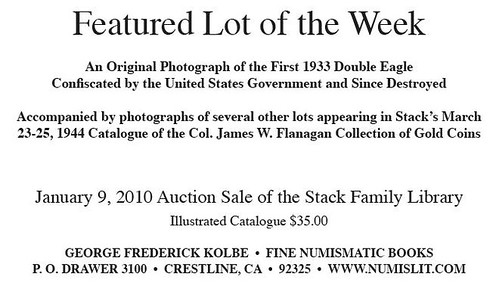
INTERNATIONAL NUMISMATIC LIBRARIES' NETWORK CREATED
American Numismatic Society librarian Elizabeth Hahn writes:
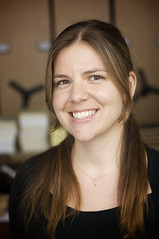 I have been working with a librarian in Holland to establish a support network to facilitate exchanging information, ideas, and publications within the numismatic library community.
I have been working with a librarian in Holland to establish a support network to facilitate exchanging information, ideas, and publications within the numismatic library community.
Last week during the International Numismatic Congress in Glasgow, we officially established the International Numismatic Libraries' Network (INLN) and already have 25 interested libraries. We are very much still in the early stages of organization, but hope to have a website up shortly, so members and the community can see what our goals are and submit their comments and suggestions.
 A new international network of scientific numismatic libraries has been established -- the International Numismatic Libraries' Network (INLN).
The aims will be to coordinate common efforts (for ex. in developing cataloguing standards) and quite generally to distribute and to exchange information, ideas, and publications.
A new international network of scientific numismatic libraries has been established -- the International Numismatic Libraries' Network (INLN).
The aims will be to coordinate common efforts (for ex. in developing cataloguing standards) and quite generally to distribute and to exchange information, ideas, and publications.
At the beginning of 2009, all ICOMON members were contacted and a survey regarding their information and library situation was sent out. Several numismatic librarians and ‘information caretakers' responded and some 25 libraries world-wide were interested in becoming a member of the network. As a result, the INLN was formally founded at the International Numismatic Congress in Glasgow (2nd and 3rd September 2009).
A website that summarizes the mission and goals of the Network is currently being developed and will be announced shortly.
For more information, please contact Ans ter Woerds (Geldmuseum, Utrecht -- a.ter.woerds@geldmuseum.nl) or Elizabeth Hahn (American Numismatic Society, New York -- hahn@numismatics.org).
NUMISMATIC AUTHORS HIGHLIGHTED IN PAPER MONEY
Some of the numismatic authors whose works we've discussed here in The E-Sylum are highlighted in the September/October issue of Paper Money, the official journal of the Society of Paper Money Collectors. Editor Fred Reed kindly forwarded copies of some photos for publication here.
The pictures of Whitfield and Reed were taken by Bob Van Ryzin. Gene Hessler supplied the picture of himself and E-Sylum regular Joe Boling at Gene's book-signing booth. -Editor

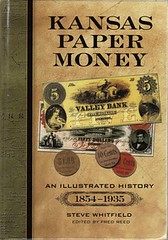
Steve Whitfield with his Kansas book (Memphis Paper Money Show)
BOOK REVIEW: KANSAS PAPER MONEY: AN ILLUSTRATED HISTORY, 1854-1935
(http://www.coinbooks.org/esylum_v12n18a06.html)

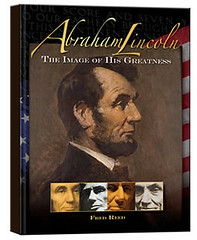
Fred Reed with his Lincoln book (Memphis Paper Money Show)
BOOK REVIEW: ABRAHAM LINCOLN: THE IMAGE OF HIS GREATNESS BY FRED REED
(http://www.coinbooks.org/esylum_v12n11a03.html)


Joe Boling at Gene Hessler book signing (Central States Numismatic Society show)
BOOK REVIEW: HEY! MISTER HORN BLOWER
(http://www.coinbooks.org/esylum_v12n20a03.html)
THE BOOK BAZARRE
UNIVERSITY OF MICHIGAN REPRINT OF PRIME'S COINS, MEDALS AND SEALS
Bill Rosenblum writes:My son Brian spent a number of years working for the Scholarly Publishing Office of the University of Michigan Library and worked on many digitalization projects. 4 1/2 years ago on my 60th birthday (It seems like only yesterday) he sent me a reprint that the University of Michigan did of Prime's 1861 edition of Coins, Medals and Seals. I am probably a bit prejudiced but I think that the quality is very good (or in numismatic terms Extremely Fine). It's very helpful to be able to use a copy of a book as a "working" copy without having to worry about ruining a rare 150 year old book. He has since moved to the University of Kansas in Lawrence where he is doing similar work, and now I'm a lot closer to my grandchildren.
To read the earlier E-Sylum article, see: UNIVERSITY OF MICHIGAN AND AMAZON.COM PRINTING OUT-OF-COPYRIGHT BOOKS (www.coinbooks.org/esylum_v12n36a08.html)
MORE ON MARDI GRAS DOUBLOON LITERATURE
Bob Knepper writes:
In last week's E-Sylum, Dick Welsh asked for information about collecting Mardi Gras "doubloons". The involved organization is the "Crescent City Doubloon Traders" at www.crescentcitydoubloontraders.com. Each year they publish a "New Orleans Mardi Gras Doubloon Swapper's Check List and Price Guide".
I was a member for awhile because a few of the doubloons include the "wildman" subject of my theme collection. Their members were friendly and helped me find some, but not all, of the wanted doubloons.
Fred Reed writes:
 For David Welsh and others interested in Mardi Gras throws,
my former colleague at Coin World Jay Guren co-authored
a great book on this topic with Richard Ugan. I'm attaching
an illustration of the cover.
For David Welsh and others interested in Mardi Gras throws,
my former colleague at Coin World Jay Guren co-authored
a great book on this topic with Richard Ugan. I'm attaching
an illustration of the cover.
As you can see the cover is die cut and an actual Mardi Gras doubloon is mounted in the cut out. It is a 1966 New Orleans Carnival Parade Schedule Medal "struck in golden aluminum . . . available exclusively to purchasers of this book," according to a legend inside.
The book was published in 1966 by Anderson Publications, New Orleans, and printed by Sidney Printing and Publishing Co., Sidney, Ohio, the parent company of Coin World owned by the Amos family. It is very heavily illustrated with pictures of the carnival doubloons and photographs of Mardi Gras, and has an extensive history of the event and the medals.
The book is dedicated "to the Spirit of Carnival in New Orleans." The book is 208 pages, with a tipped in pricing supplement. The catalog includes medals from 1884 to date of publication, catalog numbers, and estimated values up to $100 for a very, very rare 19th century Mardi Gras medal.
Readers of The E-Sylum may not be familiar with my friend Mr. Guren, now deceased, who toiled in the trenches at Coin World during the 1960s, 1970s, and 1980s following a career on Madison Avenue in New York. Think MAD MEN.
Jay's output was stupendous in the period when Coin World was a much, much larger publication than that which exists today, with large oversize tabloid issues brimming with up to 200 pages weekly. Coin World needed a lot of copy each week to fill the spaces between the prodigious ads, and Jay was adept at pounding out stories long into the night fortified by cordials from his lower right desk drawer.
Jay very rarely took a byline, and refused to join the Numismatic Literary Guild for the reason it seems that he would not join any organization that would have him as a member.
On July 21, 1987, the Numismatic Literary Guild honored Jay with a special "gotcha" award as the "unsung Hercules of numismatic writing." The award recognized Jay as the most prolific numismatic writer of the past 27 years. I believe this tribute was accomplished by our colleagues Tom DeLorey and David Alexander, who were very active in NLG. Jay died in Jackson, MS on March 19, 2002.
Although the book is long since out of print, ANA members can borrow it from the ANA Library. Call Number is RM85.M3G8. The catalog also lists Jay's offprint "Catalog of 1966 Mardi Gras Medals," no. RM85.M3G8a.
The salutation in my copy in Jay's faltering hand writing reads:
Such praise was laughingly premature in 1975 -- if it is even remotely true today with regard to the undersigned, but it surely accrues for all time to Jay Guren . . . a good friend, extraordinary gentleman, dedicated researcher and fine numismatist. Back at 'ya Jay,
To read the earlier E-Sylum article, see: QUERY: INFORMATION ON MARDI GRAS DOUBLOONS SOUGHT (www.coinbooks.org/esylum_v12n36a19.html)
VOCABULARY WORDS: COUNTERSTAMP AND COUNTERMARK
Last week Kavan Ratnatunga submitted a query on the terms CounterStamp and CounterMark. David Levy writes:
Burzio (Humberto F.- Diccionario de la moneda hispanoamericana, 1958) says that CONTRAMARCADA (Countermarked) is that coin that received a mark to change its value for whatever reason (valuation, devaluation, cancellation, nationalization, etc) and CONTRASELLADA (counterstamped) is the coin which countermark bears a part (or whole) of national arms or emblems of that political entity that is marking the coin.
Although I'm not able to locate the source, I learned a long time ago another difference between the two terms. One of them would describe a coin that was issued by a political entity and this same entity changes its value for whatever reason; the other term would describe a foreign coin that is marked by a political entity to nationalize it. Unfortunately I can't cite the source and honestly speaking the first explanation seems closer to reality.
Chris Faulkner writes:
I'm sure you're going to get many responses to the countermark and counterstamp query that appeared last week. Attached is my contribution, based in research that I have been doing for some time.
These definitions were written for my book on the Prince Edward Holey Dollar and Dump. I've been working on this book for almost twenty years and it is very near completion. I would be pleased to hear from anyone with whom I have not been in contact who has one of these coins or who has heard reports of one.
Part of my research involves an inventory of all known specimens of both the Dollar and the Dump (including forgeries and replicas), as well as the political, economic and social history of the Island at the time of their circulation. I am particularly interested in discovering the whereabouts of the example that appeared in the Sellschopp Collection, auctioned by the Swiss Bank Corporation, September 14-15, 1988, Auction 20, lot 1264. I can be reached at chris_faulkner@carleton.ca
Countermark
This term has been reserved for marks of an official or semi-official nature, that is to say, marks which have been applied by punching or stamping coined money or its substitute on some authority, whether that authority be governmental or commercial, or otherwise non-governmental in nature (e.g. the mark of a club, association or organisation of some sort, or an advertisement of some kind).
Such a definition allows that marks of this nature have not only been applied with a purpose, but that that purpose can be recognized and understood by others. The purpose in question may or may not be monetary. When the purpose is monetary, its aim is usually to designate the status or value of the specie so marked. Sometimes the aim is to void or cancel a particular example of specie, sometimes it is simply to validate a coinage substitute (i.e. a token), but most often the aim is to lend official specie a token value.
In the period of silver and gold standards, that meant a circulating value in excess of the intrinsic value of the specie to which the mark was applied. In those regions where sterling set the standard of intrinsic value, the new value effected by countermarking was referred to as a currency value. The backing of some authority was needed to ensure that the countermarked specie would circulate in exchange for goods and services at the agreed upon currency value.
Counterstamp
I take a counterstamp to mean a mark which has been applied to coined money or its substitute by punching or stamping, but without the backing of any authority. Such marks have been applied willfully and without any purpose that can be recognized or admitted by a second party. A counterstamp has no effect on the value or status of the specie to which it has been applied, unless it be to deface it and occasion its withdrawal from circulation.
A counterstamped piece may therefore continue to circulate, but without any adjustment to its agreed upon valuation. In this account, a random or miscellaneous mark applied to a coin or a token is a counterstamp. It follows, of course, that a mark that is presently taken to be a counterstamp may earn the designation countermark should it prove to have been issued by some authority whose meaning was apparent to others.
Pridmore (1975) noted that counterstamp has been used interchangeably with countermark in North American numismatics with some frequency since 1851, but that usage only became regularized following Howland Wood's publication of his standard reference on the West Indies in 1915. Pridmore proposed doing away with counterstamp altogether in favour of the much older term countermark.
The sources that have influenced my definition of these terms include the following:
Baker, Warren. 2007. Marked Impressions. Montreal: Privately Printed, pp. vi-vii.
Manville, Harrington E. 2001. Tokens of the Industrial Revolution. London: Spink, p. xiii.
Pridmore, Fred. 1975-76. "Pridmore Selects ‘Countermark' Over ‘Counterstamp'," Coinquest, 1, 2 (November 1975), 10; and Coinquest, 1, 3 (January 1976), 3.
NEW DEVELOPMENTS IN THE CASE OF THE FORMER ANA EXECUTIVE DIRECTOR
Last week we quoted a Numismatic News article by David Ganz stating:
Christopher Cipoletti, who was ousted as executive director of the American Numismatic Association, has been ordered to pay $53,500 in arbitration fees and costs to the ANA.
Well, the "fees and costs" are pretty hefty. Although my E-Sylum headline was "ARBITRATOR ORDERS FORMER EXECUTIVE DIRECTOR TO PAY ANA $53,500", ANA Governor Joe Boling writes:
I don't know if ANA has paid the arbitration fees up front and is now to be reimbursed by Cipoletti, but in either case, the ANA is not "getting" any money from him. The $53k+ is composed of a fee to the American Arbitration Association and costs to the arbitrator herself. None of that money ends up in ANA hands. I'm very surprised that David Ganz phrased it that way (or perhaps we should be blaming an editor at F&W Media, owners of Numismatic News).
Just when it seemed like it was over with an arbitrator's award, ousted American Numismatic Association executive director Christopher Cipoletti filed a motion in Colorado Springs, Colo., court seeking to overturn the arbitration award on the grounds that the arbitrator exceeded her authority. It is one of the few bases that, if correct, constitutes grounds to throw out the July decision made public recently.
In a related development, a routine request to postpone the December trial date of the former ANA trial counsel was given a decidedly non-routine denial; the court suggested that the parties prepare for trial and mediation. The combined events make for a renewed vitality to what seemed to be a closed case.
To read the complete article, see: Cipoletti Case Not Yet Closed (http://www.numismaster.com/ta/numis/Article.jsp?ad=article&ArticleId=7629)
But there is still more bubbling beneath the surface. In a September 3, 2009 filing, Cipoletti's attorneys make a motion to stay the proceedings. Their reasoning is likely to raise a few eyebrows. Here are some quotes from the public document.
Third Party Defendant Christopher Cipoletti ("Cipolctti"}, by and through his attorneys, Mulliken Weiner Karsh Berg & Jolivet, P.C., respectfully moves this Court for an Order staying further proceedings in this civil matter pending the resolution of the parallel criminal proceeding.
At the urging of the ANA and its counsel, Cipoletti is the target of an ongoing criminal investigation by the El Paso County District Attorney (the "DA") relating to the allegations asserted by the ANA in its First Amended Third Party Complaint. The allegations made in the First Amended Third Party Complaint in this case are identical to issues being investigated by the DA. It is understood by Cipoletti that criminal charges are imminent. The ANA and their lawyers have communicated with and provided information to the DA in support of an indictment against Cipoletti.
The ANA has requested a deposition of Cipoletti in this action. Because the issues the ANA will address with Cipoletti are indistinguishable from the subject of the anticipated criminal charges being brought by the DA, Cipoletti simply cannot adequately respond to the civil claims in such a way as to not implicate his state and federal constitutional rights to remain silent in the criminal investigation.
THE BOOK BAZARRE
GEOLOGY AND NUMISMATICS
Last week Chris Faulkner submitted a transcription of an account of monetary practices experienced by Sir Charles Lyell in Philadelphia in 1842, a perilous time indeed for holding paper money for any length of time. I am always interested in associations between numismatics and geology, no matter how obscure, since the two subjects are linked inextricably in my own life.
Lyell was one of the founders of the science of geology, being the principal early advocate of Uniformitarianism, the concept that holds that geological processes seen active in the present (slow erosion, deposition, dissolution, etc.) were also those that occurred in the past.
Although this idea may seem obvious today, it was not always so, and Lyell's arguments formed the foundation for other breakthrough realizations in the 19th century philosophy of science, concepts that required a great age for the earth, such as Darwin's observations on the transmutation of species.
In my library I have another 19th-century geology book that uses medieval coins to illustrate in part the principle of uniformitarianism: James Dwight Dana's Text-Book of Geology, 1863. In that book the author uses a coin conglomerate found ten feet beneath the bed of the River Dove at Tutbury, Staffordshire, England to illustrate geological processes continuing in the recent era, and to show the amount of deposition occurring in only a few centuries.
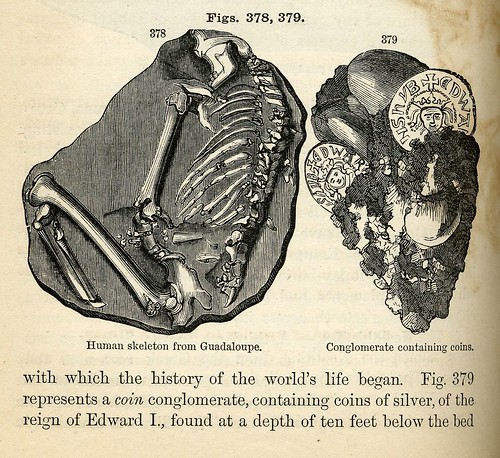
The illustration is presented alongside a depiction of an estimated 250-year-old human fossil preserved in a limestone deposit from the Caribbean. A similar illustration appears in Dana's much larger work, A Manual of Geology, also 1863, a later edition of which can be found in Google Books. To read the earlier E-Sylum article, see: HOW PEOPLE IN 1842 USED COUNTERFEIT DETECTORS (www.coinbooks.org/esylum_v12n36a18.html)
THE 1959 HAWAII GOLD STATEHOOD MEDAL
Regarding Bob Rhue's query, Jan Monroe writes:
According to my research and confirmed by Dick Johnson, only 58 of the large gold medals were struck. These medals were not numbered consecutively. Bob speculates that some may have been melted, but considering the rarity of the medal I doubt that many were melted as the issue price was $850.
The medal contains almost seven ounces of gold at .900 fine. A recent eBay sale of this medal brought $8,250 (9/12/06). Every time I have seen this medal for sale it was for more than the bullion price. -Editor
To read the previous E-Sylum article, see: QUERY: 1959 GOLD STATEHOOD MEDALS FOR ALASKA & HAWAII (www.coinbooks.org/esylum_v12n36a20.html)
MORE ON ANNIVERSARY TERMINOLOGY
Jan Monroe writes:This topic is a major theme of the book I am writing on Official State Anniversary Medals. I can say without a doubt that I have not seen any medals with many of the Gustavis Style names.
For example, the 25th anniversary medals usually just use 25th. For the 50th anniversary most medals use semi-centennial for 19th century medals and 50th for 20th century medals. Some also use golden anniversary (which I assume is based on wedding anniversaries).
For the 75th anniversary most use diamond or 75th. Centennial, bicentennial, tricentennial (or tercentenary) are also common. Quadricentennial are uncommon but mainly because the U.S. is not that old. I suspect the rest of the names given are too much of a mouth full for the average citizen.
To read the complete article, see: MORE ON ANNIVERSARY TERMINOLOGY (www.coinbooks.org/esylum_v12n36a13.html)
U.S. LARGE CENT FETCHES RECORD PRICE OVER $1 MILLION
The finest known 1795 large cent with a reeded edge sold for a record $1,265,000 Sept. 6. It was a highlight of the Dan Holmes collection of early large cents. This collection was auctioned by Ira and Larry Goldberg in association with Chris McCawley and Bob Grellman at the Beverly Hills Crowne Plaza.
Although many coins in the collection sold for record prices, the spotlight here is on the Holmes 1795 reeded edge, as this is a bewildering price for a copper coin. Greg Hannigan was the successful bidder and was acting on behalf of a collector of large cents by die variety.

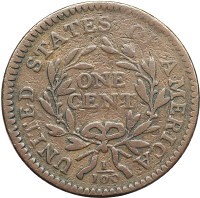
This 1795 large cent is of the die variety known as Sheldon-79. Though it is best known for having a reeded edge, it is truly a die variety, not just an edge variety. A particular die pair was used only to produce the coins that are now known as Sheldon-79.
The auction record for a copper coin has been broken a few times over the last five years. On Jan. 5, 2009, in Orlando, the finest known Strawberry Leaf cent was auctioned by Stack's for $862,500. It was NGC graded Fine-12 in 2004, and, after the Jan. 2009 auction, PCGS graded VG-10. It is curious that the finest known Strawberry Leaf cent and the finest known 1795 reeded edge cent are both PCGS graded VG-10.
Of the four known Strawberry Leaf cents, Holmes had two. Hannigan was the top bidder for both. One is PCGS graded Good-4 and it sold for $218,500. The other is of a unique variety. The placement of "ONE CENT" on the reverse is different. It is PCGS graded Fair-2 and it brought $264,500. I expected these two coins to bring more. Strawberry Leaf cents are rarer and much more famous than 1795 reeded edge cents or 1799 cents.
To read the complete article, see:
Copper record: $1,265,000 price achieved by cent
(http://numismaticnews.net/article/Copper%20record_1265000
_price_achieved_by_cent/)
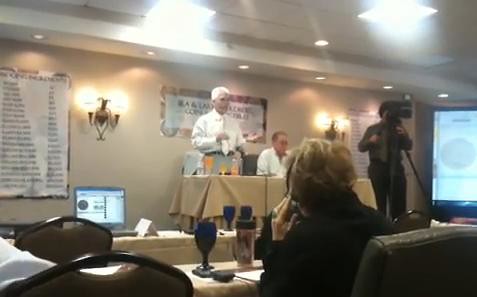
To view the auction video, see: http://www.youtube.com/watch?v=TLK6QFK9uQU
MORE ON SALMON P. CHASE AND HIS ONE DOLLAR GREENBACK
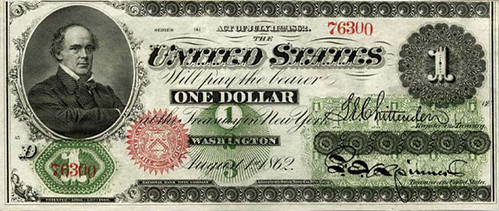
I came across your piece regarding Salmon Chase and the placement of his own portrait on the $1 bill, which references the pamphlet, "Going Home to Vote". Although it is likely that the pertinent passage from this pamphlet is likely already known to you by this time, I thought I would provide it just in case:
"The next question was, "Will you borrow the paper of the banks and give six per cent interest for it, and then pay that to the soldiers in place of gold?" Don't you think that after awhile something would have happened if I had done this? Have you not heard somewhat of revulsions and panics and crashes? Well, what would you have me do? Would you not have said to me: "here am I, Smith, a farmer; here am I, Jones, a mechanic; here am I, Robinson, a merchant. Take our property and our credit and us, and make a currency for the country based on the country itself. In other words, go to work and make 'greenbacks.'"
I know that is what you would have advised me to do; and therefore, as my business was to interpret your will -- to know what you would have me do, and then do it -- I went to work and made "greenbacks," and a good many of them. I had some handsome pictures put on them; and as I like to be among the people, and was kept too close to visit them in any other way, and as the engravers thought me rather good looking, I told them they might put me on the end of the one-dollar bills. [cheers and laughter]"
It seems to me that the speech passage certainly demonstrates Chase putting the fame generated by his portrait to advantageous political purpose, and his statement all but admits that he dictated the placement of his portrait on the $1 bill. I would think that internal government records would clarify the exact process by which the portrait/denomination decisions were arrived at, but think that even if these confirm that he dictated it there is not likely to be any clue that would constitute a smoking gun to confirm that he had more widespread distribution of his own portrait vs that of Lincoln's in mind.
There was a second quote in the "Going Home to Vote" pamphlet that records Chase mentioning his likeness on the $1 bill in another speech:
"As the speaker was retiring amid loud applause, the crowd began calling cheers for "the father of all the greenbacks." Turning again for an instant, he said, "Gentlemen, if you insist on calling me the father of all the greenbacks, you must at least admit that the children, respectable as well as numerous, bear -- a good many of them at least -- quite fair paternal likenesses. I am happy to find that they are well liked and cordially received wherever they go." (Laughter and prolonged applause)"
Chase and his daughter certainly actively promoted him by providing photographs and autographs to inquiries for such, as noted in this passage from a biography of Kate Chase:
"Kate was well aware that a good many women wrote to her father for his autograph for their albums, or else for his portrait. It was a current fad to which even Abraham Lincoln had been known to respond. Chase was always trying new photographers. Kate made a careful study of the results and helped to distribute the portraits where they would be most useful. He was undeniably one of the handsomest men on the national scene and was always gallant to women, however unresponsive to his colleagues."
I also recall reading of his leaving a torn $1 bill as a calling card for a woman he was pursuing, when she was not present at a hotel at the time he had hoped to meet her.
I recently discovered an autographed Chase calling card that features the National Bank Note Company engraving of the $1 bill vignette, trimmed to its oval border and mounted onto manila-weight card stock. The precision with which the vignette was trimmed strongly suggests that it was not a home-made production, but rather that it had been produced by a skilled Treasury Department worker.
Also of interest is that the date, February 11, 1864, lies at the precise watershed of Chase's presidential ambitions. The first of the two privately mailed anti-Lincoln pamphlets that destroyed his campaign first appeared in a newspaper the day before, and it would only be a few weeks before Chase was forced to withdraw from contention due to the firestorm the pamphlets had created.
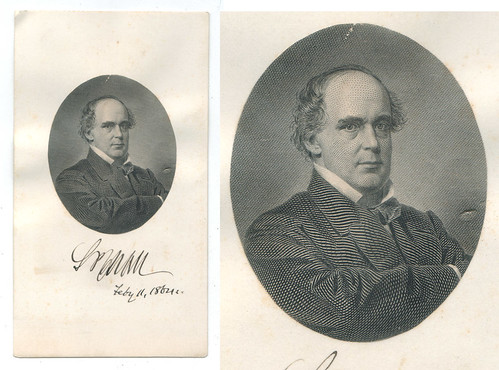
You may see a picture of this item here:
ttp://web.newsguy.com/bruceb/chase/chasecallingcard.jpg
I am not sure how much use Chase made of this National Bank Note Company engraving for self-promotion but it would be interesting to find out. I would expect that Chase-signed examples of it are not particularly common.
I came across your e-zine in the course of researching the calling card with the NBNC proof vignette and would like being placed on your mailing list. Thank you.
Perhaps some of your readers will help me clarify the fine points of this proof, and Chase's "purloining" of it for his own use -- or was it official government business use? He was Secretary of the Treasury at the time.
To read the earlier E-Sylum article, see: MORE ON SALMON P. CHASE AND ABRAHAM LINCOLN (http://www.coinbooks.org/esylum_v11n21a15.html)
IS A LIBRARY WITHOUT BOOKS STILL A LIBRARY?
Cushing Academy has all the hallmarks of a New England prep school, with one exception.
This year, after having amassed a collection of more than 20,000 books, officials at the pristine campus about 90 minutes west of Boston have decided the 144-year-old school no longer needs a traditional library. The academy's administrators have decided to discard all their books and have given away half of what stocked their sprawling stacks - the classics, novels, poetry, biographies, tomes on every subject from the humanities to the sciences. The future, they believe, is digital.
"When I look at books, I see an outdated technology, like scrolls before books," said James Tracy, headmaster of Cushing and chief promoter of the bookless campus. "This isn't ‘Fahrenheit 451' [the 1953 Ray Bradbury novel in which books are banned]. We're not discouraging students from reading. We see this as a natural way to shape emerging trends and optimize technology."
Instead of a library, the academy is spending nearly $500,000 to create a "learning center," though that is only one of the names in contention for the new space. In place of the stacks, they are spending $42,000 on three large flat-screen TVs that will project data from the Internet and $20,000 on special laptop-friendly study carrels. Where the reference desk was, they are building a $50,000 coffee shop that will include a $12,000 cappuccino machine.
And to replace those old pulpy devices that have transmitted information since Johannes Gutenberg invented the printing press in the 1400s, they have spent $10,000 to buy 18 electronic readers made by Amazon.com and Sony. Administrators plan to distribute the readers, which they're stocking with digital material, to students looking to spend more time with literature.
Those who don't have access to the electronic readers will be expected to do their research and peruse many assigned texts on their computers.
"Instead of a traditional library with 20,000 books, we're building a virtual library where students will have access to millions of books," said Tracy, whose office shelves remain lined with books. "We see this as a model for the 21st-century school."
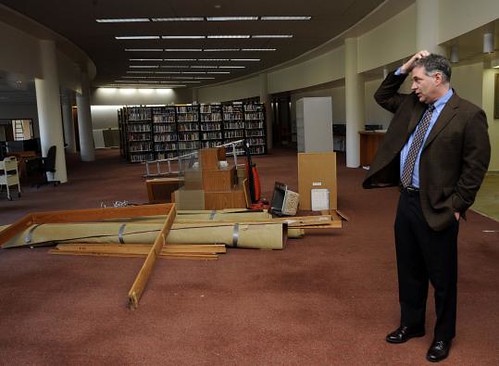
Hmmm. What's missing here?
Not everyone on campus is sold on Tracy's vision.
They worry about an environment where students can no longer browse rows of voluptuous books, replete with glossy photographs, intricate maps, and pages dog-eared by generations of students. They worry students will be less likely to focus on long works when their devices are constantly interrupting them with e-mail and instant messages. They also worry about a world where sweat-stained literature is deemed as perishable as all the glib posts on Facebook or Twitter.
Liz Vezina, a librarian at Cushing for 17 years, said she never imagined working as the director of a library without any books.
"It makes me sad," said Vezina, who hosts a book club on campus dubbed the Off-line Readers and has made a career of introducing students to books. "I'm going to miss them. I love books. I've grown up with them, and there's something lost when they're virtual. There's a sensual side to them - the smell, the feel, the physicality of a book is something really special."
Alexander Coyle, chairman of the history department, is a self-described "gadget freak" who enjoys reading on Amazon's Kindle, but he has always seen libraries and their hallowed content as "secular cathedrals."
"I wouldn't want to ever get rid of any of my books at home," he said. "I like the feel of them too much. A lot us are wondering how this changes the dignity of the library, and why we can't move to increase digital resources while keeping the books."
Tia Alliy, a 16-year-old junior, said she visits the library nearly every day, but only once looked for a book in the stacks. She's not alone. School officials said when they checked library records one day last spring only 48 books had been checked out, and 30 of those were children's books.
"When you hear the word ‘library,' you think of books," Alliy said. "But very few students actually read them. And the more we use e-books, the fewer books we have to carry around.''
Jemmel Billingslea, an 18-year-old senior, thought about the prospect of a school without books. It didn't bother him.
"It's a little strange," he said. "But this is the future."
To read the complete article, see:
Welcome to the library. Say goodbye to the books.
(www.boston.com/news/local/massachusetts/articles/
2009/09/04/a_library_without_the_books/)
MYSTERIOUS LEDGER SIX NINE FOUR: THE OLD COUNTERFEIT STAMPER
 Even More from Mysterious Ledger Six Nine Four, a turn-of-the-twentieth century newspaper scrapbook of odd and curious tales, another story leads with an illustration of a man-sized tool revealing two hundred-pound cannonballs on a long horizontal bar that twists and drives a "C-shaped" stamping jaw, titled "OLD COUNTERFEIT STAMPER"
Even More from Mysterious Ledger Six Nine Four, a turn-of-the-twentieth century newspaper scrapbook of odd and curious tales, another story leads with an illustration of a man-sized tool revealing two hundred-pound cannonballs on a long horizontal bar that twists and drives a "C-shaped" stamping jaw, titled "OLD COUNTERFEIT STAMPER"
NOW OF GOOD CHARACTER
PITTSFIELD MAN HAS AN OLD COUNTERFEITING MACHINE WHICH MADE BAD MONEY BEFORE
THE REVOLUTIONARY DAYS.
In the dooryard of Edwin L. Parker, on the shore of Onota Lake, Pittsfield, stands an old counterfeiting machine whose history dates back beyond revolutionary days, when the manufacture of spurious coin was carried on in New York and Philadelphia. No one has the authentic history of the machine and how long it was used for illegal stamping of spurious coins before it lived down its dark record by many years of honest labor and was finally retired from active operations.
The machine was used by a gang of New York counterfeiters in about 1770, whose operations attracted the attention of government officers. The coin makers sent the machine to Philadelphia in a load of charcoal. The machine was overtaken by the officers and the gang was taken back to New York, where the plates and dies were destroyed.
During the war of 1812 the machine was shipped to Pittsfield, where Lemuel Pomeroy, who made guns for the government, used it to stamp out the S-shaped plates which went on the stock of the flint-lock muskets. The gun factory burned, and the machine fell into the Housatonic River. Caleb Goodrich then bought the machine and used it for "gumming" the old-fashioned up-and-down saws used in sawing lumber. From there it was taken to the Plunkett mill and was used for a like purpose.
About 30 years ago it was purchased by its present owner of the administrator of Mr. Goodrich's estate. Soon after the circular saw came into use and there was no more use for a "gumming" machine. Since that time the machine has stood in the dooryard of Mr. Parker where it has been used as a hitching post and as a tether post for young cattle.
MYSTERIOUS LEDGER SIX NINE FOUR: THE ELLA QUINN HOARD
SHE HID $40,000 GOLD IN A BARREL.
HEIRS FOUND IT AFTER HER DEATH PACKED IN THE CELLAR
THE COINS ROLLED UP
Philadelphia Women Worth $500,000 Secreted Her Money for Years
Bridgeton, N.J. April 19 – For several years a barrel containing $40,000 nearly all in gold, was hidden in the cellar of the home of Mrs. Ella Quinn, of Philadelphia. After her death, two days ago, the fortune-laden barrel was discovered. Mrs. Quinn's estate, valued at $500,000 was divided between her heirs. Six-year-old John Quinn, of this city, inherited $60,000.
For two years previous to her death Mrs. Quinn hinted at a fortune. "If all the rest is swept away, I'll still have enough to keep me." She said. This led to a thorough search of the house. In one corner of the cellar, amid old hoops and refuse, was found the barrel. It was broken open, and gold coins in denominations from $1 to $50 rolled in a heap on the cellar floor. Some paper money of large denomination was packed in the bottom. The gold was packed tightly between layers of cotton. The barrel was lined with asbestos. For how many years the barrel remained in the cellar is a mystery.
I looked in the index to Q David Bowers' book, American Coin Treasures and Hoards and didn't find an entry for Ella Quinn's hoard.
Many thanks again to Tom for taking the time to transcribe and share these great old newspaper stories with us. Original sources like these are manna for numismatic researchers.
-Editor
Do E-Sylum readers know of similar stories regarding the loss and sketchy whereabouts of numismatic treasures not yet recovered? From rusty counterfeit stampers to barrels of gold in the basement, or even missing manuscripts and books never published, we, the most formidable community of numismatic armchair treasure hunters ever assembled, might collectively work together to solve a shared numismatic mystery. Who needs help with a little research "digging" for numismatic gold? If you haven't found it by now, perhaps you never will without help from your E-Sylum readership.
THE BOOK BAZARRE
GOOD GUYS WIN IN COIN THEFT ATTEMPT
Dick Johnson writes:
It is seldom we read what really goes on in a coin shop robbery attempt. Here is a story that you will want to read to the end. A former police officer, now an owner of two Gulf Coast coin shops, Bob Bruce was alerted of a large coin theft from a dentist in Ohio.
He was bestowed the Sol Kaplan Award by the Professional Numismatists Guild for his efforts in recovering over a million dollars' worth of stolen coins.
Whoever coined the phrase take a penny leave a penny, doesn't know Bob Bruce. Owner of two of the biggest coin shops in the Gulf Coast area, this coin collector and previous law enforcement office knows how to catch thieves red handed.
Bruce was recently awarded the Sol Kaplan Award from the Professional Numismatists Guild for recovering more than $100,000 worth of valued coins. This led to a further investigation, which helped recover over $2 million worth of coins.
Bruce said the coin thief was in a ring with a group that had helped steal over $2 million worth of coins out of a dentist's safe in Ohio.
Unfortunately, the thieves didn't have enough brains to crack the safe code, so they did the next best thing—they pulled the safe through the wall.
"They hooked the safe up to a trailer and pulled it out of the house. It did a lot of damage to their house," said Bruce.
"The guy came in and tried to sell these expensive coins, and he didn't know how to handle them. That's when we knew they were stolen," said Sullivan.
Once a meeting was set up to sell the coins, FBI agents hid in the back room of his Pensacola store. "I had FBI agents in the back with machine guns," said Bruce.
"They had been looking for this guy for a year," said Bruce, "He had walked up behind some guy and shot him in the head."
Bruce had no problem dealing with the thief, and was the first to jump at the man when he reached for his gun.
After an all-out brawl, which was later posted on youtube.com, all of the people involved in taking down the armed man walked away with some kind of injury.
To read the complete article, see:
Local coin shop owner awarded
(http://www.srpressgazette.com/news/penny-8233-
whoever-local.html)
BILL FIVAZ AND THE U. S. FRIGATE CONSTELLATION MEDALS
Jim Wells writes:
I read with interest in last week's E-Sylum about the search for information about U.S.F Constellation medals possibly produced by Wendell's.
This may be a long shot - but as editor of the San Diego Numismatic Society's Bulletin, last month I performed my monthly "look-back" at activities 50 years ago, 40 years, etc.
The September 1959 Bulletin reported that "Member Bill Fivaz (LTJG, USN) of Coronado has medals that have been struck to raise funds for the restoration of the U.S. Frigate Constellation, oldest ship of the U.S. Navy. These medals were made from copper bars and spikes, stamped 1808 and 1812, which have been removed during the course of repairs.
Bill, being a Navy man himself, has a supply of these medals and he would be very glad to sell you a copy. They are only $1.00 each and may be secured from him at the meetings ... All money raised by the sale of these medals will be used to restore the Constellation, the first ship of the United States Navy."
Bill has since left San Diego moved on to bigger and better things, but perhaps he still has some information on those medals he was promoting.
To read the earlier E-Sylum article, see: THE U. S. FRIGATE CONSTELLATION MEDALS (www.coinbooks.org/esylum_v12n36a22.html)
COMMEMORATIVE $150 BANKNOTE ISSUED IN HONG KONG
Standard Chartered today opens the floodgates for the great Hong Kong banknote stampede, offering a million banknotes that no one will ever spend, but everyone wants to own.
The first ever HK$150 banknotes, printed by Standard Chartered Bank (Hong Kong) to celebrate its 150-year presence in the city, are likely to spark a frenzy from collectors and speculators.
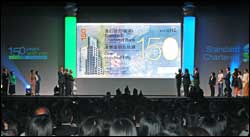
The commemorative banknotes will be legal tender here, but no one in his right mind would try to buy anything with them. One coin dealer predicts that anyone who gets his hands on a set of 35 uncut HK$150 notes will be able to rake in HK$100,000 for them - and their value will continue to soar.
"By design, we want the banknote to be unique and the only one of its kind. We want it to represent the spirit of the city," the bank's Hong Kong chief executive Benjamin Hung Pi-cheng said yesterday.
Standard Chartered has also selected 100 notes with special lucky serial numbers for public bidding and another 10,000 pieces for which the public can pick a serial number of their choice.
There are three categories of lucky number notes, with minimum bid prices of HK$10,000, HK$6,000 and HK$3,000. The "single self-selected serial number" notes will be offered at HK$888 each by lottery.

The front of the banknote, designed by Austrian graphic designer Henry Steiner, who has designed banknotes for Standard Chartered since 1975, features a satellite image of Victoria Harbour with the lender's corporate blue and green as the main color tones.
The back features eight Hong Kong people from different generations looking at the city's evolution.
To read the complete article, see:
New $150 notes are real bang for the buck
(http://www.thestandard.com.hk/news_detail.asp
?pp_cat=30&art_id=87578&sid=25296811&con_type=3)
BANK OF JAMAICA ELIMINATES UNUSUAL CIRCULATING COIN SHAPES
Bank of Jamaica wishes to advise that new-shaped One and Ten Dollar coins will go into general circulation on 8 September 2009.
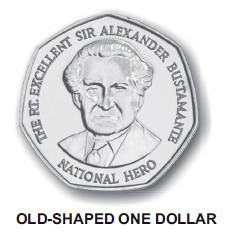
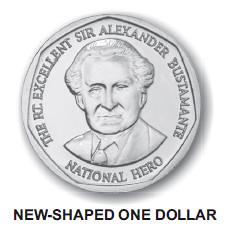
The current seven-sided design (heptagonal) of the One Dollar will be replaced by a round coin with the heptagonal shape within the circle. The coin continues to bear the portrait of The Right Excellent Sir Alexander Bustamante, National Hero. All other technical specifications remain unchanged.

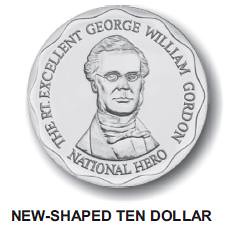
The current scalloped-shaped design of the Ten Dollar will be replaced by a round coin with the scalloped shape within the circle. The coin continues to bear the portrait of The Right Excellent George William Gordon, National Hero. All other technical specifications remain unchanged.
Coins bearing the old designs remain legal tender and will continue to circulate alongside the new-shaped coins until the stock of the old-shaped coins is exhausted. Bank of Jamaica
Do any of our readers specialize in odd-shaped coins of the world? Is there a trend toward eliminating unusual shapes? If so, why? Are they just more expensive to produce than normal round coins?
The process of making gradual design changes is one of the oldest tricks in the marketing book. At first glance the old and new coins look very much alike despite their different shapes. It's like the new coins sport a picture of the old ones, which reminds me of the old practice of picturing the equivalent coin on a banknote of the same denomination. For example, many U.S. scrip notes of the 1830s pictured the equivalent Spanish coin or fraction thereof. Has some professor ever coined a word for this phenomenon?
QUICK QUIZ: how many different examples of picturing coins within a coin or banknote can you name? Provide images where possible, and we'll have some fun with this topic next week.
-Editor
WAYNE'S NUMISMATIC DIARY: SEPTEMBER 8, 2009
On Tuesday I had some visitors here at the E-Sylum Central Office; members of my monthly northern Virginia numismatic social group Nummis Nova came to my house before dinner for a brief tour of my numismatic library.
At about 6pm Max the Wonder Dog started barking. I picked him up (he only weighs about nine pounds) and opened the door for Tom Kays, Jon Radel and David Schenkman. After Max got past his barking stage and met my guests he began to settle down. Before long he was laying on his back getting belly rubs from Tom.
My library is in my office, situated just to the left of our front hallway. Ten bookcases line the walls, holding about 3,000 volumes. I gave a quick overview - these two cases hold most of the rare and antiquarian books. Next, in order, are biographies of numismatic figures, general works (like Roger Burdette's Renaissance of American Coinage series, Breen's Encyclopedia and several Q. David Bowers works). After that I have a couple shelves of books on U.S. Colonial Coinage followed by a shelf of mint histories (The Philadelphia Mint, Charlotte, Dahlonega, Denver, etc.).
Then come books arranged by denomination - works on U.S. half cents, large cents, small cents, nickels, dimes, etc. through double eagles. Next are books on patterns, commemoratives, errors, counterfeits and grading.
The next section holds books on banking followed by a shelf and a half on U.S. colonial paper money. Following that are books on obsolete paper money, civil war paper money, National Bank Notes, depression scrip, and U.S. paper money.
(Whew!) After paper money are sections on counterfeiting and lottery tickets. Next up are tokens and medals, with sections for Hard Times Tokens, Civil War Tokens, Pioneer Gold, Counterstamps, etc. A big section is arranged alphabetically - Architectural Medals, Assay Medals, Bolen tokens, Bryan Money, etc... Indian Peace medals, Military Medals, Political items, So-Called Dollars, Transportation tokens, etc.
That's it for U.S. subjects, but another bookcase and a half holds works on Ancient coins, Canadian, Mexican and British numismatics, world paper, and more biographies of numismatic figures.
A glass-front barrister bookcase holds a partial leatherbound set of Numismatic Scrapbook, a complete set of Coin Collector's Journal, a long run of U.S. Mint Reports and other items. A couple two-shelf cases in front of my desk hold a set of Historical Magazine, runs of Bowers and Ruddy/Merena and George Kolbe hardbound auction catalogs, a complete hardbound set of Stack's John J. Ford sales, and a group of proceedings of the Numismatic and Antiquarian Society of Philadelphia.
Spanning the top of five side-by-side bookcases is my bound set of The Numismatist and atop that are over fifty three-ring binders holding numismatic catalogs and ephemera in archival sleeves.
Tom Kays was curious about works on counterfeiting, so I pulled out for him a group of several Heath's Counterfeit Detectors and my binder of counterfeiting pamphlets and ephemera. Later he browsed my shelf of other books on counterfeiting.
I pulled out a few of my rare early books to show, including Barton's 1813 Life of Rittenhouse, Crosby's Early Coins of America, and Bushnell's Early New York Tokens, 1864. See below for images of some of the books.
Tom had brought a medal with him for attribution. Dave Scheckman recognized it as something in DeWitt. I pulled the DeWitt book off the shelf and we quickly located Tom's piece. A also took a look in Atwood's transportation token catalog.
Max the Wonder Dog barked some more as others arrived. He met Chris Neuzil and Roger Burdette and as with the others, he managed to calm down after a few minutes. I'd been afraid I'd have to lock him in his crate, but he was fine.
Roger bought me two DVDs holding parts of his latest research project - U.S. Assay Commission records (Vol II 1873-1892, Vol III, 1893-1911). There will be four disks in all.
I passed around my latest acquisition - a fortunate eBay purchase of a privately printed leatherbound history of the Carnegie Hero Fund Commission, issuer of the Carnegie Hero Medal.
We had a grand time and could have gone on for hours, but it was soon time for dinner. At about 7pm the group headed for their cars. By then my wife Dee and our three kids had returned to the house and were playing a pickup game of basketball in our cul-de-sac. I stuck around awhile to play and talk with Dee and our neighbors. When Dee took the kids in for their baths I hopped in the car and drove a couple miles to the Ashburn Bertucci's restaurant.
Tom, Jon, Dave, Chris and Roger were already there along with Howard Daniel and Wayne Herndon who were unable to meet early enough for the library visit. Others in our group (Traci Poole and Julian Liedman) were traveling to the Long Beach Coin Show and couldn't attend. So it was a small group, but just as enthusiastic as ever.
Tom passed around a box of coins asking everyone to evaluate which were real and which were fake. There were a number of contemporary circulating counterfeits. Most of us did pretty well on the quiz - I kinda flubbed it.
Dave Schenkman passed around a little buying guide from a Virginia coin dealer. I'd never seen this item before. Howard mentioned that the Army War College has asked him to write up his experiences in the Vietnam War, and he'd written over a hundred pages so far. Howard's the nicest guy around, but also the toughest. Let's just say that if Nummis Nova had a Sergeant-at-Arms, Howard would be our man, hands down.
Before dinner was over I passed around something of my own - my library guest book. Stephen Pradier had given it to me. He had it made by Longs-Roullet Bookbinders as an example of their work. When I had a bus tour of Numismatic Bibliomania Society members visit my library during the 2004 Pittsburgh American Numismatic Association convention, I had everyone sign the book and inscribe a message.
When I moved to Virginia my library and guest book came with me. Roger Burdette and Douglas Saville signed it next on separate occasions. Tonight Chris, Jon, Dave and Tom added their John Hancocks. Thanks, guys. What good is a numismatic library if you can't share it with friends? Below are some images so I can share a few items with all of my readers.
It was a great evening, and as always I was disappointed to see it end. But I'm already looking forward to next month.
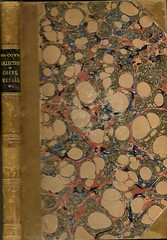
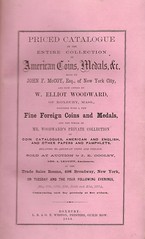
Woodward's McCoy Sale
W. Elliot Woodward, Priced Catalogue of the Entire Collection of American Coins & medals, &c. Made By John F. McCoy, Esq., of New York City, and now owned by W. Elliott Woodward of Roxbury, Mass., together with a Few Fine Foreign Coins and Medals and the Whole of Mr. Woodward's Private Collection of Coin Catalogs, American and English, and Other Papers and Pamphlets, Relating to American Coins and Coinage, May 17th-21st, 1864. Priced and named copy.

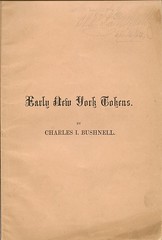
Bushnell, Early New York Tokens, 1864
Bushnell, Charles L., Early New York Tokens, 1864. I bought this from the sale of Armand Champa's library. It's a small pamphlet housed in a beautiful 3/4 leather book box.

Chapman, S.H. & H, Bushnell sale, 1882
Chapman, S.H. & H, Catalogue of the Celebrated and Valuable Collection of American Coins and Medals of the Late Charles L. Bushnell, Esq., of New York, Philadelphia, 1882. This is a plated copy of the sale of Bushnell's collection, from the library of Donald M. Miller.

Dye's Coin Encyclopedia, 1883 Dye, Kohn S., Dye's Coin Encyclopedia, A Complete Illustrated History of the Coins of the World, Philadelphia, 1883.
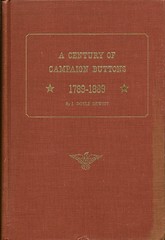
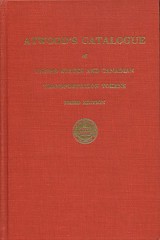
DeWitt, American Campaign Buttons and Atwood's Transportation Tokens
DeWitt, J. Doyle, A Century of American Campaign Buttons 1789-1889, Hartford, CT, 1959
Atwood, Roland C., Atwood's Catalogue of United States and Canadian Transportation Tokens, Third Edition, Boston, MA, 1970
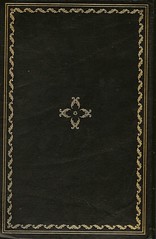
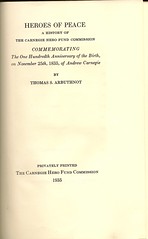
Arbuthnot, Heroes of Peace, 1935
Arbuthnot, Thomas S., Heroes of Peace, A History of The Carnegie Hero Fund Commission Commemorating the One Hundredth Anniversary of the Birth, on November 25th, 1835, of Andrew Carnegie., 1935
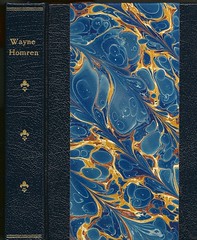
CORRECTION: ASHMOLEAN MUSEUM'S HEBERDEN COIN ROOM NOT YET OPEN
Regarding last week's note that Ashmolean Museum's coin room was open, Howard Berlin writes:
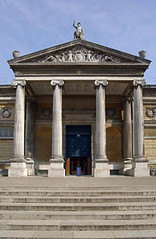 I'm not sure if your information is correct. As I would be in London in November, I was planning to make a day trip to Oxford on 11/4 to visit the Ashmolean as it was under "redevelopment" when I was there in 2007.
I'm not sure if your information is correct. As I would be in London in November, I was planning to make a day trip to Oxford on 11/4 to visit the Ashmolean as it was under "redevelopment" when I was there in 2007.
I e-mailed Dr. Heuchert to let him know of my plans and he returned the following:
I will delay my visit to 2010 during another of my visits to London.
NEW ZEALAND MEDAL THIEF PLEADS GUILTY
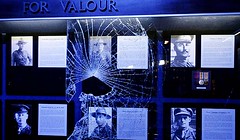 A man has pleaded guilty to the burglary of the Waiouru Army museum in 2007.
A man has pleaded guilty to the burglary of the Waiouru Army museum in 2007.
Another man still faces charges in connection with the incident when he appears in the Wanganui District Court for a depositions hearing on October 27.
An extensive manhunt and national outrage followed the theft of medals from a display case.
The Waiouru haul was huge. Among the 96 medals stolen were nine Victoria Crosses, including Charles Upham's VC and Bar - the only double VC decoration awarded to a combat soldier. Two rare George Crosses, an Albert Medal, a Distinguished Conduct Medal and Military Medal were also taken.
Even on a world scale, the Waiouru raid was unprecedented - comparable to the theft of major international artworks.
Going by overseas auctions in recent years, the haul was estimated to be worth $10 million, easily making it the biggest robbery in New Zealand criminal history.
Australian War Memorial Museum curator Nick Fletcher said at the time: "I don't think there's ever been a bigger theft than this before. No larger group of significant medals has been stolen like this."
The recovery of the medals was also significant.
It is believed that only one of the 15 other Victoria Crosses known to have been stolen worldwide since the mid-1800s have been recovered - and that one, stolen from the Canadian War Memorial Museum in 1973, was missing for 31 years.
British billionaire Lord Ashcroft, who owns the largest VC collection in the world - more than 140 VCs, or one in 10 of all those awarded since 1856, rates the Upham VC and Bar as the "Holy Grail."
To read the complete article, see: Guilty plea over Waiouru medal theft (http://www.stuff.co.nz/dominion-post/national/2851874/Guilty-plea-over-Waiouru-medal-theft)
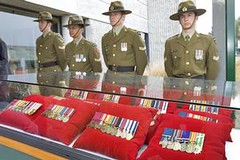 The guilty plea from one of the men accused of stealing rare war medals from the Waiouru Army Museum has been welcomed by the museum director, who says the robbery took a terrible toll on his staff.
The guilty plea from one of the men accused of stealing rare war medals from the Waiouru Army Museum has been welcomed by the museum director, who says the robbery took a terrible toll on his staff.
Colonel Raymond Seymour said the guilty plea was "marvellous news ... It brings closure to a terrible crime."
A 39-year-old man pleaded guilty yesterday in the Auckland District Court to the museum burglary on December 2, 2007. He was remanded in custody until next month.
Colonel Seymour said staff were badly affected by the thefts. "I don't think people realise the impacts the thefts had on my staff. They were just absolutely devastated. They were custodians of national treasure."
After the thefts, it was "like someone stole the heart from the museum", he said.
Ninety-six medals, including nine Victoria Crosses, two George Crosses and an Albert Medal, were stolen from locked display cabinets that were supposed to be protected with reinforced glass. Security at the museum has been improved since the burglary.
The medals have been back on display since October and have been a major draw for visitors.
To read the complete article, see: Medal thief's guilty plea delights Army museum
LUCKY COIN PLACED ATOP JOHNSTON SMOKESTACK
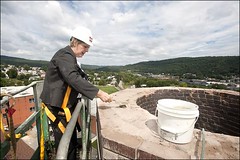
Greater Johnstown School District Superintendent Barbara Parkins and James Knox Polk shared something in common Thursday.
Parkins and the 11th president of the United States were more than 85 feet above the ground as part of a good luck ceremony at Johnstown Middle School.
"What we did was we climbed 85 feet to the top of the smokestack and placed a gold coin on the top for good luck," she said.
The dollar coin bearing the president's image, was placed there at the behest of RG Friday Masonry-Concrete of Pittsburgh, contractor for the $1 million restoration of the building.
"We know the gold coin signifies good luck," Parkins said. "It was something that was recommended by our construction company."
Parkins and job foreman Bob Boeltz rode the lift to the top of the smokestack.
"It was nice looking at the surrounding areas and the Pennsylvania hills," Parkins said.
More than 400 students peeked from classroom windows to witness the unusual ceremony.
To read the complete article, see: Schools chief places coin atop smokestack (www.tribune-democrat.com/local/local_story_254005105.html)
THE CAT ATE MY HOMEWORK - AND MY LUNCH MONEY, TOO
Judges have refused to overturn a decision by German bank bosses who would not replace a 500 euro note after a customer claimed it had been eaten by his cat.
The court in Frankfurt ruled that to prove the claim Peter Neumann would have to rescue undigested scraps of the banknote from his pet's litter tray and present them as evidence for an appeal.
Judges said that they wanted to be completely sure that it was from a single note which had been eaten by a cat.
But Neumann said: "I have already searched through lots of cat litter and I probably threw out the evidence without realising.
"It's not that I don't want to go looking through pet excrement to get what's rightfully mine, it's just that the evidence really isn't around any more. I don't know what else I can do."
To read the complete article, see: 'Cat ate 500 euro note' (www.ananova.com/news/story/sm_3473275.html)
FEATURED WEB SITE: WATERMARKS
This week's Featured Web site is suggested by John and Nancy Wilson, who write:
www.motherbedford.com/watermarks/
WatermarksMain.htm
